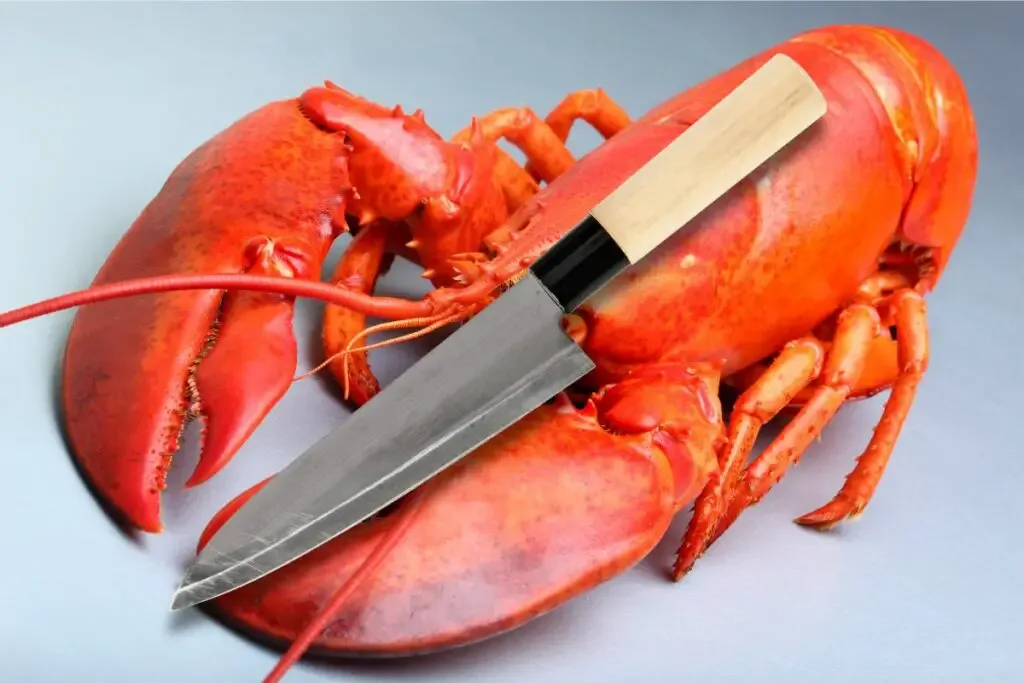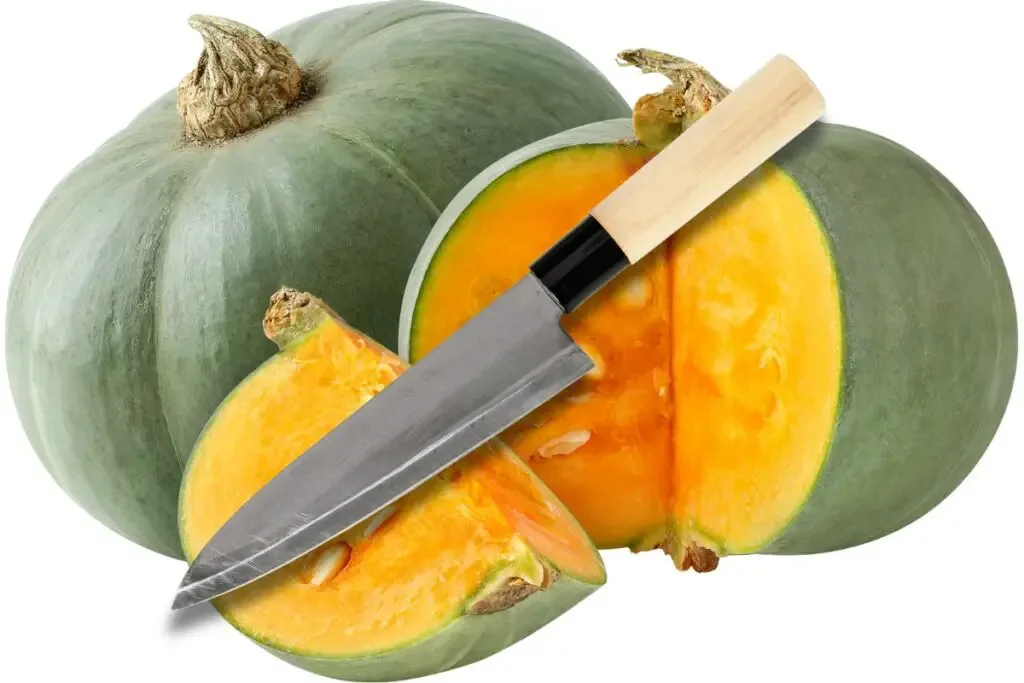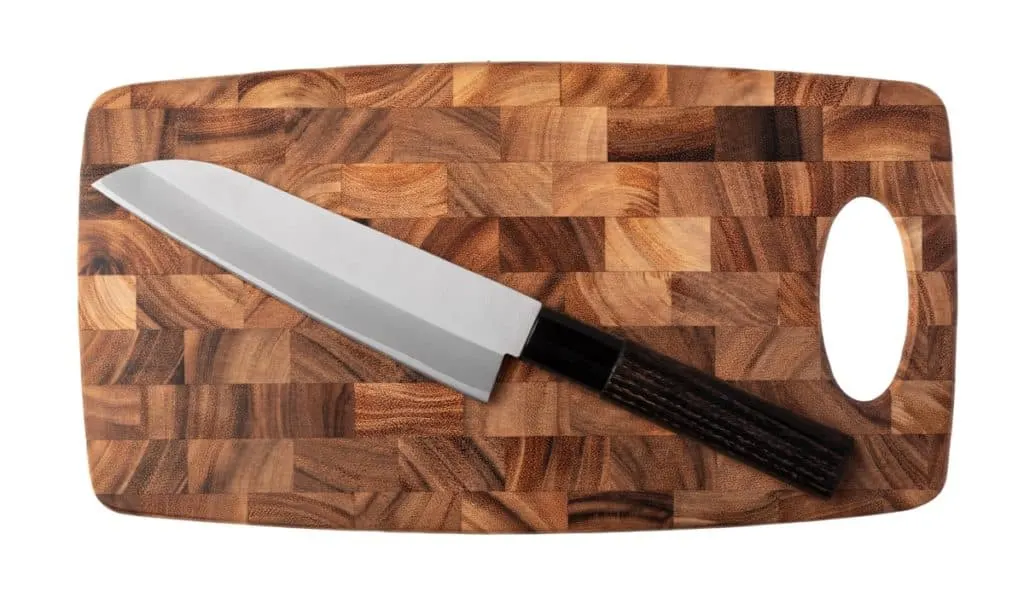As an Amazon Associate, we earn from qualifying purchases with no additional costs for you.
A Japanese kitchen knife is a precision tool that should not be treated as a multi-purpose utility knife. Japanese knives are an expensive investment and are built with specific cutting tasks in mind. It would be devastating to chip or break the edge of your expensive Japanese knife because you used it inappropriately. What items should you never try to cut with your Japanese knife?
You should never cut bone, shellfish shells, frozen foods, or hard-skinned vegetables with your Japanese knife. The edge could chip or crack, requiring an expensive repair or the replacement of the knife. Care should also be taken to use an appropriate cutting board to prevent edge damage.
Each Japanese knife is designed for a particular purpose in the kitchen, which means that the blade has certain characteristics making it ideal for that task.
Using the knife unintentionally or intentionally for a purpose that was not designed is courting disaster for your expensive knife. Good knife care is not only how you clean and sharpen the knife but also how you use it. You may even have to change your knife skills to avoid damage to the knife!
If you are interested in checking out the best Japanese knives (made by Hayate Yoshihiro) we recommend and use you can find them by clicking here (Amazon link).

What You Should Never Cut With Your Japanese Knife
The characteristic of Japanese knives that makes them superior to other kitchen knives is the thinness of the cutting edge, which allows the knife to be extremely sharp, providing precise, accurate, and clean cuts.
To retain the sharpness of such a thin edge on the knife, the metal must be very hard; otherwise, it would fold over and become dull in a very short time. Japanese steel has a chemical makeup that supports the metal’s hardened to higher levels than many other steel types.
The tradeoff of such a thin, hard edge is that the metal becomes brittle and susceptible to chipping and cracking when not used correctly.
As a result, care must be exercised on the types of ingredients you cut with the knife, and paying attention to your cutting action to preserve the knife’s edge.
Never Cut Bone With A Japanese Knife
Cutting into bone is probably one of the leading causes of damage to a Japanese knife in the kitchen. This can inadvertently happen when processing meat of various types and accidentally cutting into bone embedded in the meat that you overlooked.
The bones of large animals such as cattle, pigs, sheep, and goats are extremely hard. Pushing a Japanese knife’s thin, brittle edge into hard bone can chip or crack the steel on the sharp edge.
Poultry bones are relatively soft compared to larger animals, and many Japanese knives are designed specifically for processing these meat birds.
However, the knife blades are only designed to cut through the softer connective tissue between the joints rather than the bones themselves.
Large poultry bones can be as damaging to the blade as large animal bones, causing chipping and cracking. One of the most common types of blade damage to Japanese poultry processing knives is a broken tip.
People push the tip of the knife into a larger joint in the poultry and then twist the knife to separate the joint. This is a dangerous use of the blade and often results in the tip of the knife snapping off!
Never Cut Shells With A Japanese Knife

Seafood is a sought-after part of our cuisine, but many shellfish come with some impressive armor! Crustaceans such as lobster, crayfish, crabs, and the like have hard external shells that you need to get through to access the meat.
Never use your Japanese knife to cut the claw off crab or lobster or to cut through the hard exoskeletons of these creatures!
These shells are as hard as bone and can inflict similar damage to your knife’s sharp edge in the form of cracks and chips.
Never Cut Frozen Foods With A Japanese Knife
Freezing ingredients is a good way to keep them useful for longer, and with some ingredients, they are much easier to cut when they are frozen.
Even though some ingredients are easier to cut when frozen, you should never use your Japanese knife for this task, even for frozen foods that have thawed a little.
The hardness of the frozen food is like cutting into any other hard object with the edge of your knife; the edge can chip or crack.
Even if the food has thawed slightly, the middle section could still be frozen solid, which will damage the edge of your Japanese knife.
Never Cut Hard Skin Vegetables With Your Japanese Knife

Many vegetables, notably the pumpkin and squash family, have very tough outer skins that can be difficult to cut through.
The skin on these vegetables can be as hard as the shells on some shellfish, so if you should not use your knife on those items, you should not use them on hard-skinned vegetables.
The same chipping and cracking of the thin sharp edge of the knife can occur if you use your knife to cut through the skin.
Once the vegetables have had their skins removed using a more appropriate knife, you can certainly process the inner flesh with your Japanese knife.
TIP: The internet is full of fake Japanese knives, so you need to be careful when buying one. Find out how to spot fake Japanese knives in the article below:
Spotting FAKE Japanese Knives: 8 Features To Watch Out For
Other Uses That Can Damage Your Japanese Knife
There are other aspects of using your Japanese knife that you need to have in your mind when you reach for your knife to process your ingredients.
It is not only the type of ingredients you must be mindful of when using your knife but also the surface you are cutting on, which brings us to the topic of cutting boards.
Cutting Boards Can Damage Your Knife Edge

Cutting on a firm surface promotes easier processing of the ingredients, but you need to consider the board’s material to prevent damage to your knife.
A solid surface is a requirement for a cutting board, but a hard surface that has no give can be damaging to the knife’s edge as you push your knife through the ingredients and onto the board.
Cutting boards made from glass, metal, granite, or marble should never be used with any knife, let alone Japanese knives.
These cutting boards may look very chic in your kitchen, but they will destroy the edge of your blades every time you cut or chop on these boards.
Cutting boards made from hard plastics, bamboo, and edge-grain hardwoods can also chip or crack the edge of your Japanese knife.
The best cutting board to use with a Japanese knife is an end-grain wood chopping board or a soft plastic chopping board.
These cutting boards will not last as long as the rigid boards, but they will be cheaper to replace than repairing or replacing your Japanese knife!
BTW: If you want to know more about Japanese and other knives and their sharpening, check out the books listed above. These books are recommended by professional sharpeners and knife makers (Amazon links):
- Japanese Kitchen Knives: Essential Techniques and Recipes
- The Knifenerd Guide to Japanese Knives
- Knife: The Culture, Craft, and Cult of the Cook’s Knife
- Sharp: The Definitive Introduction to Knives, Sharpening, and Cutting Techniques, with Recipes from Great Chefs
TIP: Hard steel of Japanese knives is brittle, so impacts or torsion on the edge can chip the blade’s cutting edge. Find out how to fix a chipped Japanese knife at home in the article below:
DIY: Fixing A Chipped Japanese Knife In 4 Simple Steps
Scraping Laterally With The Blade
Any lateral scraping with the sharp edge of your knife is a dangerous habit with a Japanese knife. The edge is designed to be strong in the knife’s forward and backward or up and down motion.
Any lateral scraping with the knife or twisting the blade during or after the cut can chip the thin edge. Some people have the habit of using the knife blade to scrape the sliced ingredients across the chopping board away from their work area.
As the knife slides laterally along the chopping board, it can chip the blade’s thin edge.
Likewise, scraping laterally along an ingredient with the knife’s edge to remove skin or outer coverings can cause one part of the blade to flex while the remainder of the edge stays in one place.
The brittleness of the metal combined with this twisting action can cause the thin edge to crack or to chip!
In the same way, if your chopping or slicing technique is not in a single plane and you twist the blade laterally at the end of a slice or chopping action, the same damage can result.
Our choice: If you want to buy Japanese knife we recommend checking out the amazing Japanese knives made by Hayate Yoshihiro company. All knives made by this company are very high quality and durable. Check out their Amazon store here (Amazon link).
FAQs on Japanese Knife Usage: Clarifying Common Queries
We have put together a list of common questions asked regarding Japanese kitchen knives as a quick reference for those looking for additional information on Japanese knife usage.
1. Can Japanese knives be used to cut bones? No, Japanese knives are generally not recommended for cutting bones as they have delicate edges and can easily chip or break. Use a cleaver or a Western-style knife designed for such tasks.
2. Is it safe to cut frozen foods with Japanese knives? Cutting frozen foods with Japanese knives is not advised due to the risk of chipping or damaging the blade. Allow foods to thaw before cutting them with a Japanese knife.
3. How often should Japanese knives be sharpened? The frequency of sharpening depends on usage, but a good rule of thumb is to sharpen your Japanese knife when you notice a decrease in performance or when it fails the paper-cutting test.
4. Can Japanese knives rust? Yes, especially those made from high-carbon steel, which is prone to rusting if not properly maintained. Keep the knives dry and consider using blade oil for added protection.
5.What cutting boards are best for Japanese knives? Softwood cutting boards, like those made from hinoki or soft maple, are ideal as they are gentle on the blade and help maintain its sharpness.
6. Can I use a honing rod on my Japanese knife? It’s generally preferable to use a whetstone. However, if you choose to use a honing rod, opt for one that is ceramic and ensure to use it gently to avoid damaging the blade.
7. Why do Japanese knives chip easily? Japanese knives are often made with harder steel and are sharpened to a finer edge compared to Western knives, making them more susceptible to chipping, especially when used improperly.
8. Can I put my Japanese knife in the dishwasher? No, Japanese knives should be hand-washed with mild soap and water and immediately dried to prevent rusting and handle damage.
9. Is it normal for Japanese knives to discolor or patinate over time? Yes, especially for knives made from carbon steel. Patina can actually protect the blade and enhance its flavor-neutral properties. However, red or orange discoloration is a sign of rust and should be removed.
10. Can I use Japanese knives to cut hard vegetables like butternut squash? Care should be taken when cutting hard vegetables. Use a rocking motion to gently cut through, and avoid using excessive force or twisting the blade to prevent damage. Understanding the proper use and care of Japanese knives is crucial to maintaining their performance and longevity. By being informed and addressing common queries, users can avoid common pitfalls and enjoy the unparalleled precision and craftsmanship of their Japanese knives.
Conclusion
The descriptions of the damage that can occur when misusing a Japanese knife may give the impression that these knives are too delicate.
This is certainly not the case but rather implies that the knife should be used with care and used for its intended purpose rather than a general kitchen tool.
When used correctly, a Japanese knife is a precision cutting tool that is a pleasure to use; just don’t use it in a role it was not intended for!
TIP: Original Japanese knives are expensive but definately worth of money. Do you know how to care about Japanese knives properly? Check out the ultimate guide about taking care of Japanese knives in the article below:
How To Care For Japanese Knives: The Complete Guide
